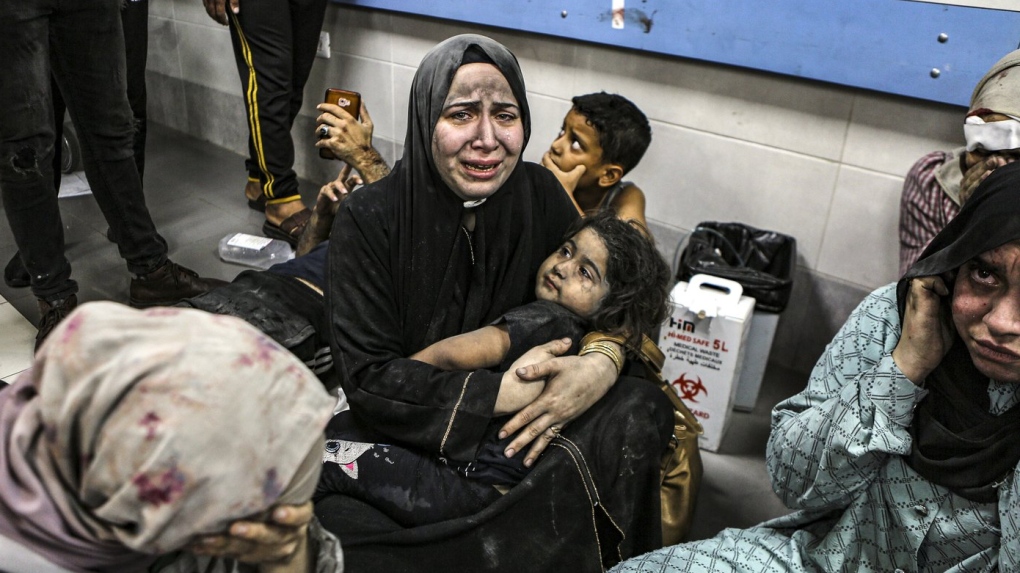As war is waged on the ground, Hamas and Israel are also fighting a modern-day conflict on the social media battleground.
For weeks now, both Hamas and the Israel Defense Forces have been producing and sharing their own content as they fight for the hearts, minds and support of the global community, says Kaitlynn Mendes, a sociology professor at Western University.
“Social media really gives both sides the power to tell their own story, to frame the conflict with their own agenda,” says Rogers, who notes, “If we think of this as a larger PR campaign, they want to get international support, they want to get the public’s support for continuing military operations.”
One example of the communication battle happening in real time occurred on Oct. 17. On that day, reports surfaced that Gaza's Al -Ahli Hospital was hit by a missile, resulting in a large number of fatalities and injuries. Hamas immediately blamed Israel, protests erupted and the incident even led to Arab leaders cancelling an emergency meeting with U.S. President Joe Biden that was scheduled to take place in Jordan.
Online and on the streets, people from across the globe condemned Israel. Hours after the incident, Israel issued a denial, as they released their own satellite images online claiming the hospital was hit by Islamic Jihadists who misfired a rocket from inside Gaza.
 Palestinians wounded at Ahli Arab hospital sit on the floor at al-Shifa hospital, in Gaza City, central Gaza Strip, Tuesday, Oct. 17, 2023. The Hamas-run Health Ministry says an Israeli airstrike caused an explosion that killed hundreds at the Ahli Arab hospital, but the Israeli military says it was a misfired Palestinian rocket. (AP Photo/Abed Khaled)
Palestinians wounded at Ahli Arab hospital sit on the floor at al-Shifa hospital, in Gaza City, central Gaza Strip, Tuesday, Oct. 17, 2023. The Hamas-run Health Ministry says an Israeli airstrike caused an explosion that killed hundreds at the Ahli Arab hospital, but the Israeli military says it was a misfired Palestinian rocket. (AP Photo/Abed Khaled)
Though, by the time Israel issued their denial, which was backed by the U.S. Department of Defense, who cited their own intelligence, the opinions of many were seen in protests across the world and on social media. The public had already made up their mind.
“During a previous war, 15 years ago, Hamas was greatly outpaced by the Israelis on social media,” says Philip Seib, a professor emeritus of journalism and public diplomacy at the University of Southern California. Seib notes that “since that time, Hamas has made efforts to catch up to Israel on the social media battlefield.”
The number of new followers on Hamas-linked channels on the messaging app Telegram have skyrocketed since the conflict began. On Oct. 7, when Hamas launched its deadly attack inside Israel, many in Israel and in Gaza first learned of what was happening through posts shared on Hamas-associated Telegram pages.
Mendes believes that there’s a “social media war” taking place, one that is closely interlinked with the conventional warfare taking place in Gaza. “On both sides of the conflict, they understand the power of images, of storytelling, and the technology is at a point where it’s simple to edit videos so it can be more sympathetic to your side,” says Mendes.
Seib recently wrote and released the book “Information at War: Journalism, Disinformation and Modern Warfare.” He believes both sides are filming and editing their own videos and pushing their own propaganda online at record speed.
“The Israelis can say what they want to say and reach the entire social media universe. Hamas can do the same thing,” he points out. And so can their supporters. The production qualities on social media from each side of this conflict are growing more advanced by the day.
“We're not just seeing raw footage, we're seeing footage that's sometimes backed by music that can make you feel a certain way, whether it’s sadness, anger or rage,” says Mendes. As the war between Israel and Hamas rages on, fact-checkers have stressed the need to be careful spreading photos and videos appearing on social media that purport to illustrate the violence on the ground. A person uses a cellphone in Ottawa on Monday, July 18, 2022. THE CANADIAN PRESS/Sean Kilpatrick
As the war between Israel and Hamas rages on, fact-checkers have stressed the need to be careful spreading photos and videos appearing on social media that purport to illustrate the violence on the ground. A person uses a cellphone in Ottawa on Monday, July 18, 2022. THE CANADIAN PRESS/Sean Kilpatrick
Those who spoke to CTV National News for this story share that for those searching for factual news and information, the sheer volume of misinformation being shared on social media is making the fog of war that much more dense and confusing to navigate.
“We now have the rise of synthetic media, the rise of AI generated images. It makes it incredibly difficult to know if what we’re seeing is real. Whether it was from this conflict, or a different conflict, or if these images have been created using AI technology,” says Mendes.
The proliferation of videos and posts are also leaving social media sites vulnerable. The European Union has launched an investigation into Elon Musk’s X, formerly known as Twitter, over the reported spread of terror, violent content and hate speech since the start of the war.
The investigation, the first under the EU’s new tech legislation, will look at the way complaints over posts were handled by the social media company.












































